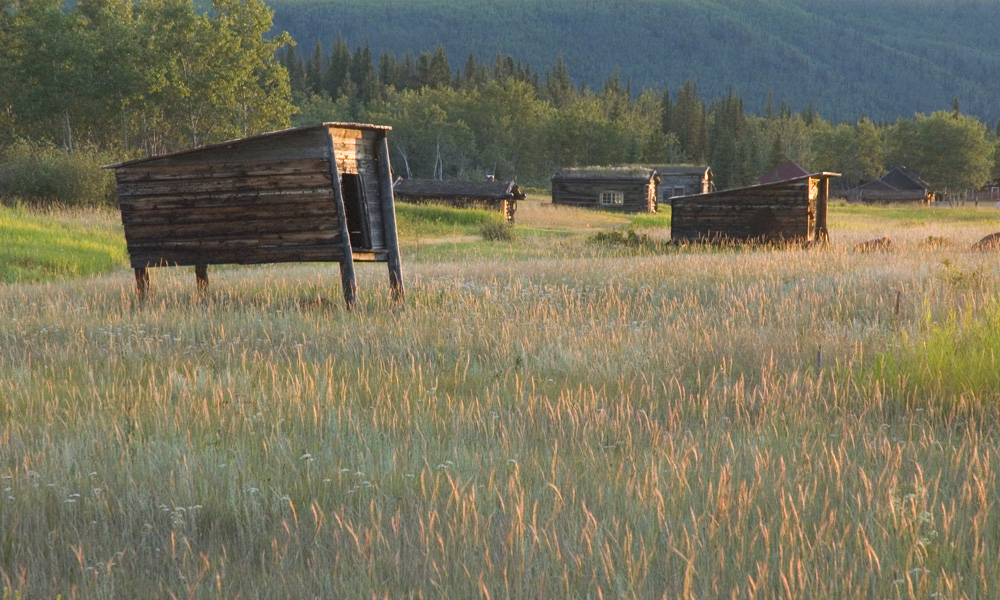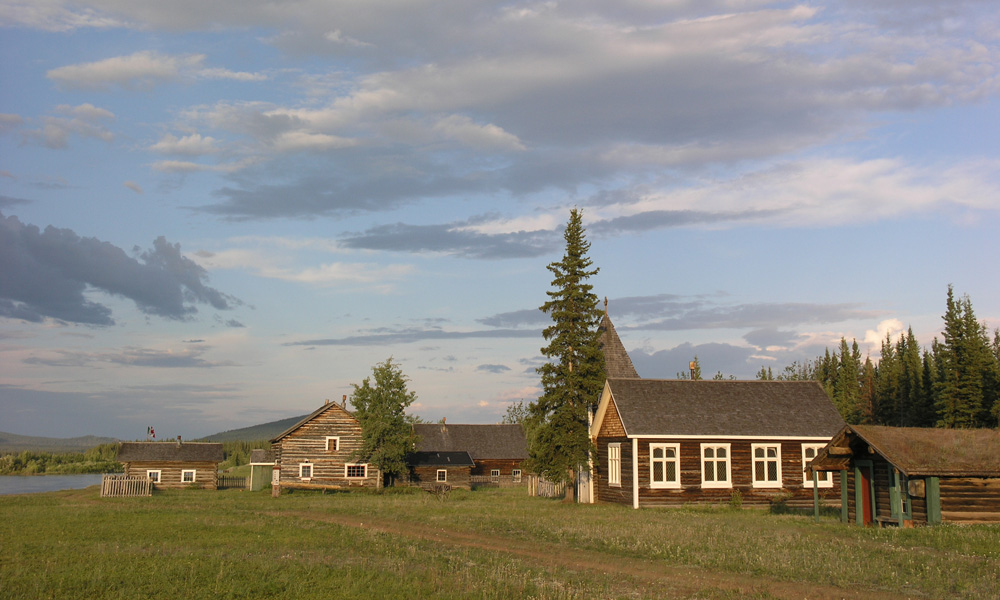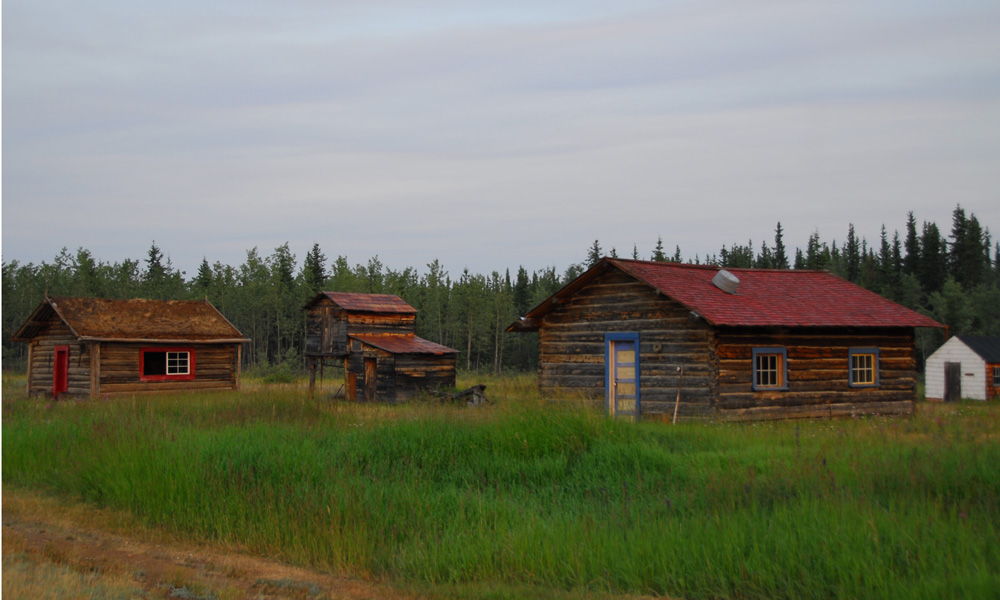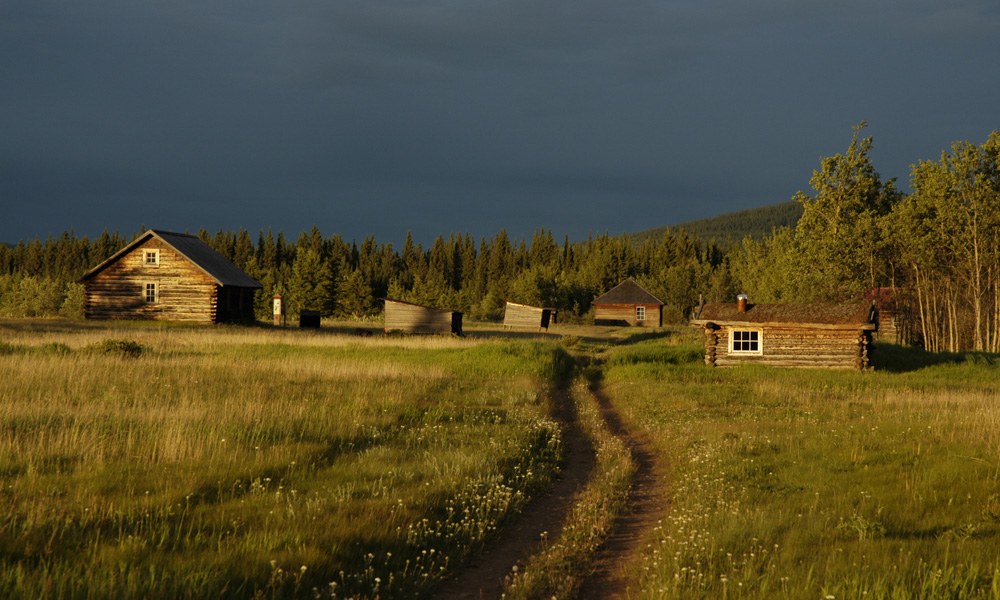The historic site of Huchá Hudän / Fort Selkirk lies within the Traditional Territory of the Selkirk First Nation. It is a 50-hectare site that is located on the terrace of the Yukon River near the mouth of Pelly River. The Site is approximately 51 km by a winding gravel road from Pelly Crossing and an additional 10 km by boat.
Fort Selkirk is set in a beautiful river valley rich in natural resources and surrounded by a mountainous, boreal landscape with a dynamic geological record. Fort Selkirk illustrates the unique contribution and combination of different cultures and natural environments that have helped form the social, economic and political fabric of the territory. The site also illustrates the historic trading economy, the transportation development of the Yukon, the sovereignty of Canada, and the early expansion of the church and community life in a northern isolated area. Fort Selkirk is central to the homeland of the Northern Tutchone and their cultural traditions such as game harvesting, trade and travel. This place has been a traditional harvesting and gathering site for thousands of years.
A permanent community evolved in the early 1890s with the establishment of a trading post and an Anglican Church mission. The community grew quickly as thousands of stampeders headed for Dawson City during the Klondike Gold Rush in 1896. Throughout the first half of the 20th century, Fort Selkirk remained a stable, thriving community where two cultures lived, worked, played and prayed together. Abandoned in the 1950s due to the construction of modern roads and the end of sternwheeler traffic, members of the Selkirk First Nation and other Yukoners continue to think of it as their ancestral home
In accordance with Chapter 13, Schedule A, of the Selkirk First Nation Final Agreement, the Fort Selkirk Historic Site is co-owned and co-managed by the Selkirk First Nation and Yukon Government. The site was designated as a Yukon Historic Site under the Historic Resources Act in August 2010. The Fort Selkirk Heritage Management Plan has been updated to reflect the review of the vision, goals and objectives of the historic site.
The Management Committee designated by Selkirk First Nation and Yukon Government was established to guide the planning process and continues to guide the conservation and maintenance of the historic site. Community engagement is important in the planning process for Fort Selkirk, there were many opportunities for sharing, commenting and reviewing the plan as it went forward.
The Huchá Hudän / Fort Selkirk Heritage Management Plan was approved and signed by Selkirk First Nation and Government of Yukon on August 20, 2021.
See the Government of Yukon News Release #22-241 for August 23, 2021 ‘Updated Huchá Hudän/Fort Selkirk Historic Site Management Plan in place’
Stay tuned to this page for updates and information as conservation efforts continue.
View the following Fort Selkirk resources:
Fort Selkirk 'Walking Tour' Guide (n.d.)
Fort Selkirk Management Plan (2021)
Fort Selkirk Management Plan (2000)
Fort Selkirk Interpretation Plan (1994)
| Attachment | Size |
|---|---|
| December 2025_Huchá Hudän NEWSLETTER.pdf1.33 MB | 1.33 MB |
| January 2025_Huchá Hudän NEWSLETTER.pdf1.54 MB | 1.54 MB |
| Spring 2024_Huchá Hudän NEWSLETTER.pdf1.25 MB | 1.25 MB |
| Fall 2023_Huchá Hudän NEWSLETTER.pdf1.35 MB | 1.35 MB |
| June 2023_Huchá Hudän NEWSLETTER.pdf978.79 KB | 978.79 KB |
| 2022 December_FORT SELKIRK NEWSLETTER.pdf1.15 MB | 1.15 MB |
| June 2022_FORT SELKIRK NEWSLETTER.pdf1.15 MB | 1.15 MB |
| 2021_12 Fort Selkirk Newsletter.pdf2.13 MB | 2.13 MB |
| 2021_06_FtSelkirk Newsletter.pdf659.68 KB | 659.68 KB |
| HS_FS_newsletter_DEC2020_WEB.pdf771.75 KB | 771.75 KB |
| HS_FS_newsletter_AUGUST_2020.pdf727.13 KB | 727.13 KB |
| Fort Selkirk_newsletter_FEB 2020.pdf1.17 MB | 1.17 MB |
| Fort Selkirk_newsletter_April_2019.pdf1.15 MB | 1.15 MB |
| Fort Selkirk March_2019 Newsletter_Three.pdf6.68 MB | 6.68 MB |
| Fort Selkirk October Newsletter_Two.pdf7.43 MB | 7.43 MB |
| Fort Selkirk Spring Newsletter_One.pdf735.14 KB | 735.14 KB |
| 1996 Fort_Selkirk_Archaeology_0.pdf5.02 MB | 5.02 MB |
| 1990 Fort Selkirk Management Plan web.pdf28.74 MB | 28.74 MB |




